A Scream on Ben Nevis
And proud Ben Nevis hear with awe
How, upon bloody Quatre-Bras,
Brave Cameron heard the wild hurra
Of conquest as he fell.
….
Sons of the spear!
You feel us near
In many a ghastly dream;
With fancy’s eye
Our forms you spy,
And hear our fatal scream.
With clearer sight
Ere falls the night,
Just when to weal or woe
Your disembodied souls take flight
On trembling wing–each startled sprite
Our choir of death shall know.
Sir Walter Scott, “The Dance of Death”. 1815.
“Climbers mystified by ‘bloodcurdling screaming’” read the headline of a piece written for the BBC by Christopher Sleight, the Out of Doors producer for BBC Radio Scotland, published on February 20th, 2015.[1] It’s the sort of headline that a major news organization doesn’t usually go for, unless we’re reading a fictional headline in the opening paragraph of something by H.P. Lovecraft.
But Mr. Sleight’s story was very real: as he relates it, the climbing conditions in western Scotland over the past few months have been the best in years. Days of “gentle freeze-thaw cycles have created vast swathes of thick, sticky ice of the best quality.” In February, 2015, Sleight was among a great many hikers and climbers who made way for Ben Nevis, the highest mountain in the British Isles, presumably after hearing tell of some of the finest climbing conditions on any Scottish peak in recent memory. He and his climbing partner set off on an ice route called Comb Gulley, “a gully high in the corrie that’s bounded by the Trident Buttress on one side and the steep walls of Tower Ridge on the other.”
ADVERTISEMENT
During the course of this climb, while hanging off “very steep ground” – Sleight began to hear something:
“It started indistinctly, slightly muffled, but quickly came sharp into focus. It pierced through the mist – the most visceral, awful sound.
People talk about bloodcurdling screaming and for the first time I understood. That noise sent a stream of cold blood around my veins and chilled the back of my neck.
My first thought was simple but terrible: I was listening to someone who had just watched a loved one – not simply a climbing partner, but a loved one – fall to their death. There was so much pain and loss in that dreadful noise.”
And that was it. Sleight hoisted his partner up to his level and they discussed the scream. At this point, Sleight believed that he had actually heard the sound of a climbing accident – presumably, the sound was a person actually screaming while watching another person falling to their death. In any case, Sleight and his partner rushed to finish their planned climb, in expectation that some sort of rescue operation would be descending on the Ben shortly.
They waited on the Ben Nevis plateau in total silence. As Sleight puts it, “Something dreadful had happened. Surely we should be hearing the beginnings of a rescue – confident voices coming out of the fog.” But there came no confident voices or helicopters with spotlights. There was, probably, just the eerie fogged silence of being on a mountain in Scotland.
Later, after he and his partner had descended to Fort William, Sleight asked around if any other climbers in the area had heard the scream, which they had. He even spoke with a few individuals who actually went off their routes in search of the source of the sound, who found nothing:
“Other climbers did the same. Nobody could find evidence of an accident and the police said no-one had been reported missing. So we don’t know who was screaming. We don’t know what happened to them. We probably never will.”
Once there was presumably some consensus reached among climbers that there had been, in fact, the sound of a pained scream on Ben Nevis that day, the Lochaber Mountain Rescue Team was mobilized to investigate. They also found nothing. Christopher Sleight was at a loss to address what he and the other climbers on the Ben heard that day, and his article for the BBC is devoid of any speculation. It is, more or less, a warning about how dangerous ice-climbing can be, wrapped around a curious and intriguing anecdote about a mysterious scream.
Ben Nevis, as mentioned before, is the highest mountain in the British Isles at 1,344 metres (4,409 ft) above sea level. Like many of the higher points in the Scottish Highlands, The Ben is actually the remains of a supervolcano that collapsed in on itself around 350 million years ago.[2] The mountain itself cuts an imposing figure – it is one of the few mountains in the British Isles with a truly mountainous silhouette, with jagged snowy peaks reaching up from the hills as though they’d slice the Scottish sky – and as such, it is a destination for mountaineers of all stripes in the United Kingdom. The future Master Therion Aleister Crowley actually summited the peak himself in the summer of 1890, at the ripe old age of fifteen. [3]
Compared to some of the other peaks in the Highlands (and the country of Scotland in general), the Ben is interestingly somewhat devoid of its own supernatural belief legends. Ben MacDui in the Cairngorms has the Big Grey Man Am Fear Lliath Mòr, a kind of giant grey wild-person spectre who drives mountaineers into a deadly panic.[4] Ben Cruachan in Argyll and Bute is haunted by the Cailleach nan Cruachan “the witch of Ben Chruachan”, though she seems better understood as a local aspect of an ancestral fairy-hag/mother-goddess. In any case, the particular divine hag Cailleach (“old woman” or “hag” in modern Irish and Scottish Gaelic) [5] who makes her home on Ben Chruachan stands accused in local legend of accidentally creating the nearby Loch Awe when the well she was attending overflowed while she slept. [6] Lochs Ness and Morar (and a handful of others less famously so) are haunted by their own kelpie-like monsters; there is really no limit to the fairy-beings that populate the landscape of the British Isles.
Christopher Sleight’s account of the scream on Ben Nevis in February 2015 brings to mind a particular fairy, who in Scotland is called the bean sìth (bean sìth in Scots Gaelic bean “woman” and sìth “fairy”, in Old Irish she is bean sídhe, “fairy woman”, in modern English: “banshee“). [7] Banshees, or fairy women, are known for their lament. [8] They announce impending death with a scream that many, and I presume Christopher Sleight might, describe as “bloodcurdling”. Often a particular family or clan will have their own attendant banshee, and occasionally, upon the death of a truly great man or woman, there can be heard an entire host of the wailing bean sìth. [9] [10]
And though we tend to associate banshees with Ireland, the same lamenting fairy woman is also prevalent in the folklore of the Scots, Welsh,[11] & Norse.[12] Though there are differences, the banshee also begs comparison with global ghostly women in mourning, like La Llorona,[13] and the “White Lady” ghost theme found throughout the world. [14]
In modern depictions the banshee is seen as a pernicious or even openly malevolent being who literally brings death with a scream, but traditionally, her screams are prophetic laments: a banshee would scream for one who is already dead or has been fated to shuffle their mortal coil in short time; she might also mourn a family member who has died in a distant land, her voice being the first indication to the deceased’s family that their loved one’s voyage has ended in death. A banshee doesn’t bring death, she prophetically weeps for it; her gift of sight allows her to begin mourning before the rest of us. The banshee is an omen embodied, not an evil being necessarily, but one who gives voice to an evil event.
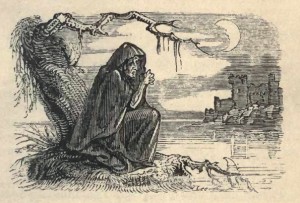
Bunworth Banshee, Fairy Legends and Traditions of the South of Ireland by Thomas Crofton Croker, 1825. Illustration by W.H. Brooke
And now again:
My first thought was simple but terrible: I was listening to someone who had just watched a loved one – not simply a climbing partner, but a loved one – fall to their death. There was so much pain and loss in that dreadful noise.
Hark! … Again, methinks, I hear her weeping
Yonder! is she near me now, as then?
Or was but the night-wind sweeping
Down the hollow glen?
– A Lamentation
For the Death of Sir Maurice Fitzgerald, Knight, of Kerry, who was killed in Flanders, 1642.
From the Irish, By Clarance Mangan [15]
[1] http://www.bbc.com/news/uk-scotland-highlands-islands-31550374. Accessed 3/12/15.
[2] http://www.bbc.com/news/science-environment-18674655. Accessed 3/10/2015.
[3] Kaczynski, Richard (2010). Perdurabo: The Life of Aleister Crowley (2nd ed.). Berkeley, California: North Atlantic Books. p. 573
[4] Shuker, Karl (1996). The Unexplained. Carlton Books. pp. 36–37.
[5] Robertson, Boyd; Ian McDonald (2004). Gaelic Dictionary. Hodder Education, Teach Yourself Series. pp. 24–25.
[6] http://www.visitcruachan.co.uk/about/history.asp. Accessed 3/11/2015.
[7] Yeats, W. B., Irish Fairy and Folktales. p. 155. Originally published in 1892. This edition: New York: Fall River Press.
[8] Yeats, W. B., Irish Fairy and Folktales. p. 155. Originally published in 1892. This edition: New York: Fall River Press.
[9] Ibid.
[10] Westropp, Thos. J. (June 1910). “A Folklore Survey of County Clare”. Folklore (Taylor & Francis): 180–199
[11] Wiffen, B. B., Choice Notes from “Notes and Queries”, P.P. – London. – Notes and Queries, William John Thoms. p. 32
[12] Orchard, Andy (1997). Dictionary of Norse Myth and Legend. Cassell.ISBN 0-304-34520-2
[13] Perez, Domino Renee, There Was a Woman: La Llorona from Folklore to Popular Culture
[14] http://en.wikipedia.org/wiki/White_Lady_(ghost) (accessed 3/11/2015)
[15] Yeats, W. B., Irish Fairy and Folktales. p. 159-161. Originally published in 1892. This edition: New York: Fall River Press.
MORE GREAT STORIES FROM WEEK IN WEIRD:


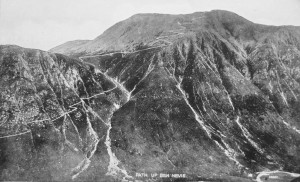
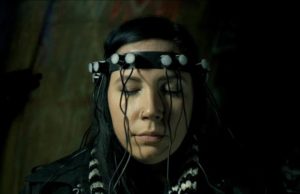
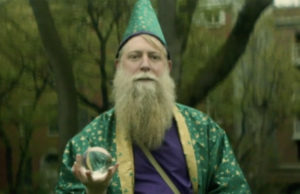
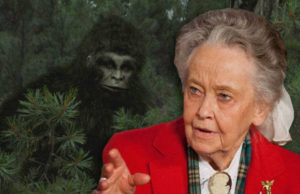

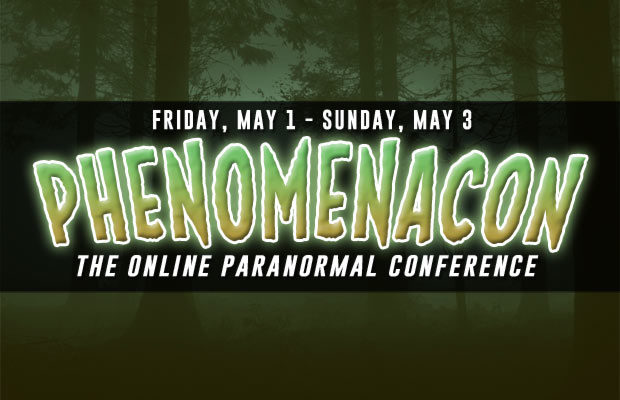
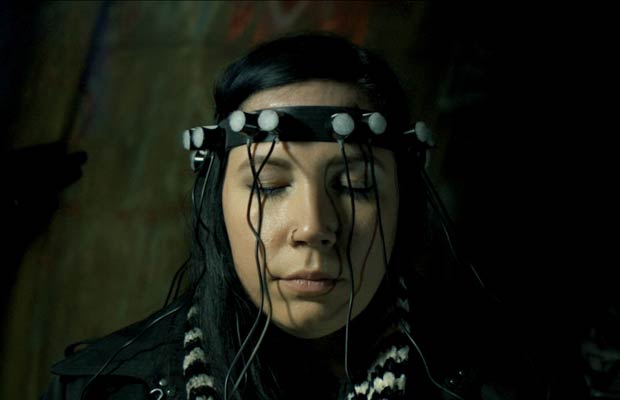

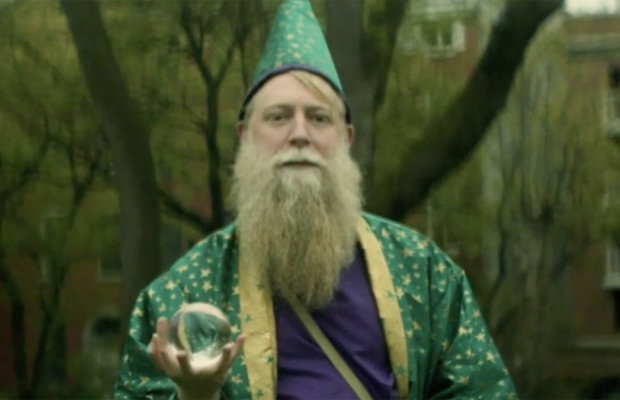

You must be logged in to post a comment Login